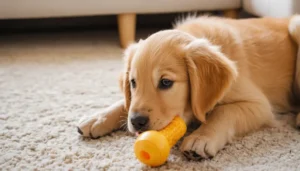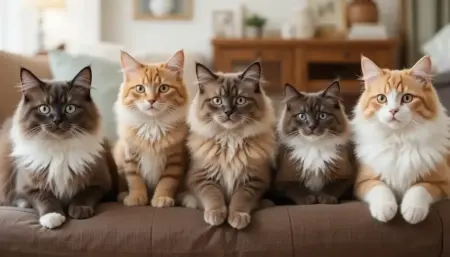Exotic cat breeds are distinctive feline varieties known for unusual coat patterns, striking physical traits, and often a higher level of activity compared to typical domestic cats. These breeds may have been developed from wild ancestors, selective breeding, or unique genetic mutations, and they usually require specialized care.
Whether you’re curious about a spotted Bengal, a hairless Sphynx, or a bobcat‑like Savannah, this guide breaks down temperament, health, grooming, legal considerations, and more, so you can make an informed decision.
What Defines Exotic Cat Breeds?
The term exotic cat breeds refers to domesticated cats that possess features seldom seen in everyday house cats. Unique coat patterns, wild‑type body structures, hairlessness, or recent hybrid ancestry (e.g., a serval parent) set them apart.
Because many of these breeds retain a higher prey drive and an inquisitive, sometimes demanding personality, they often need more mental and physical stimulation than a standard tabby.
Understanding these core characteristics helps you match a breed’s needs with your lifestyle.
Core traits that make a breed “exotic”
- Unusual appearance – spots, rosettes, stripes, or no fur at all.
- Distinctive body shape – long limbs, large ears, or a muscular build.
- Hybrid lineage – recent crosses with small wild cats.
- Elevated energy and intelligence – they love to explore, solve puzzles, and interact with people.
Popular Exotic Cat Breeds and Their Key Traits
Below is a quick‑look table that compares the most sought‑after exotic cat breeds.
Use it to spot the breed that matches your aesthetic and activity level, then read the breed‑specific sections for deeper insight.
| Breed | Adult Size | Coat/Pattern | Life Expectancy | Origin | Signature Feature |
|---|---|---|---|---|---|
| Bengal | 8–15 lb | Spotty, marble, short | 12–16 yr | Domestic × Asian leopard cat | Leopard‑like spots |
| Savannah | 12–25 lb | Tall, spotted, lean | 12–20 yr | Domestic × Serval | Long legs, large ears |
| Sphynx | 6–12 lb | Hairless, wrinkled skin | 8–14 yr | Natural mutation (Canada) | No fur, warm‑to‑touch skin |
| Egyptian Mau | 6–10 lb | Spotted, short | 12–15 yr | Ancient Egyptian domestic cats | “Go‑go” spotting |
| Toyger | 7–15 lb | Striped orange‑brown | 12–15 yr | Domestic × Bengal (USA) | Miniature tiger look |
| Peterbald | 6–12 lb | Hairless or fine down | 10–14 yr | Russian mutation | Slender, elongated body |
| Highlander | 12–20 lb | Polydactyl, bobbed tail | 12–16 yr | Domestic × Wild‑type (USA) | Extra toes, rugged look |
| Pixiebob | 9–15 lb | Short, bobcat‑like | 12–16 yr | Domestic × “Bobcat” myth (USA) | Short tail, bobcat markings |
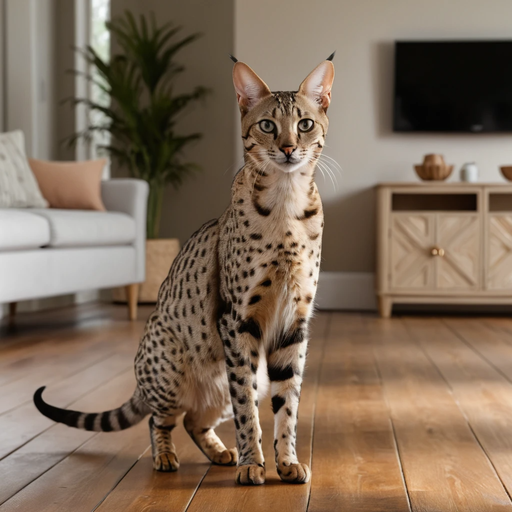
Bengal
Developed in the 1970s by crossing a domestic cat with the Asian leopard cat, the Bengal is medium‑sized, muscular, and loves interactive play.
Its short, glittery coat needs a weekly dry brush to remove dander. High protein (30 %+ on a dry‑matter basis) and daily puzzle toys keep a Bengal happy and healthy.
Savannah
A Savannah results from a domestic cat × serval cross, yielding tall, lean cats with huge ears and a powerful prey drive. They require tall cat trees, safe outdoor enclosures, and a diet rich in animal protein.
Regular joint supplements (glucosamine) are wise for the larger F2‑F4 generations.
Sphynx
The hairless Sphynx is a mutation‑born breed that revels in warmth and human contact. Because there is no fur to soak up oil, bathe the cat every 1–2 weeks with a mild, fragrance‑free shampoo, then dry thoroughly.
Add omega‑3 oil to the diet to support skin health and prevent dryness.
Egyptian Mau
The only naturally spotted domestic cat, the Egyptian Mau, is agile, fast, and loves high‑energy play.
Weekly brushing prevents hairballs, and a balanced diet with moderate calories maintains its sleek frame.
Toyger
Bred to look like a miniature tiger, the Toyger sports bold, dark stripes on a bright orange base.
Friendly and people‑oriented, it thrives on at least two 15‑minute play sessions daily and benefits from a high‑quality protein diet.
Peterbald
Peterbalds may be completely hairless or have a fine down coat. Their elegant, slender bodies and large ears make them curious explorers.
Moisturize their skin with a kitten‑safe lotion and feed a protein‑rich diet; they enjoy occasional wet food for extra hydration.
Highlander
Highlanders are known for extra toes (polydactyly) and a rugged appearance. They are adventurous climbers and need sturdy cat furniture. Because of their size, joint health supplements become important as they age.
Pixiebob
With a short, dense coat that echoes a bobcat’s, the Pixiebob is a strong hunter that loves “fetch” games. Regular brushing removes loose hair, and a diet high in animal protein supports its muscular build.
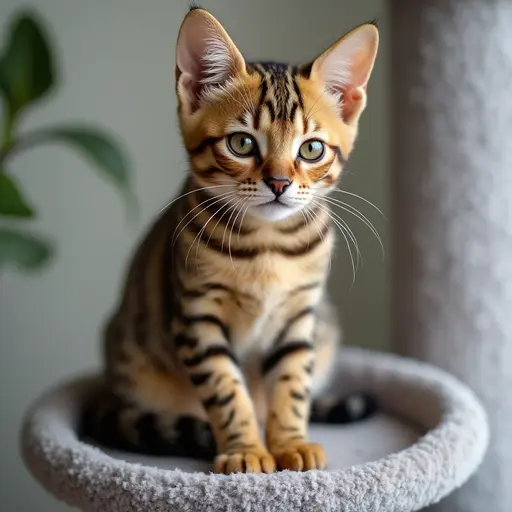
Temperament and Personality of Exotic Cat Breeds
Exotic cat breeds often share personality patterns that differ from the typical, easy‑going house cat. While each breed brings its flair, the following traits are common across many exotic cats:
- High intelligence – They learn tricks quickly and enjoy puzzle feeders.
- Strong prey drive – Expect lively hunting play; supervise outdoor time with small birds.
- Deep social attachment – Many follow their owners from room to room and thrive on human interaction.
- Vocal communication – Some, like Bengals and Savannahs, “talk” to get attention.
- Need for enrichment – Boredom can lead to destructive behavior, so rotate toys and provide climbing opportunities.
Personality snapshot by breed
| Breed | Core Personality Trait |
|---|---|
| Bengal | Playful explorer |
| Savannah | Adventurous high‑energy |
| Sphynx | Affectionate lap cat |
| Egyptian Mau | Agile and curious |
| Toyger | Confident and loyal |
| Peterbald | Curious people‑oriented |
| Highlander | Bold and independent |
| Pixiebob | Stoic hunter |
Matching a breed’s temperament with your daily rhythm helps create a harmonious home.
Common Health Issues in Exotic Cat Breeds
Because many exotic cat breeds have been selectively bred for dramatic looks, they can carry breed‑specific health concerns. Early detection and routine veterinary care are essential.
| Health Issue | Breeds Most Affected | Typical Signs | Preventive/Management |
|---|---|---|---|
| Hypertrophic Cardiomyopathy (HCM) | Savannah, Bengal (some lines) | Rapid breathing, lethargy | Annual cardiac ultrasound; medication if needed |
| Progressive Retinal Atrophy (PRA) | Egyptian Mau, Sphynx | Night blindness, gradual vision loss | Genetic testing, regular eye exams |
| Kidney Disease (PKD) | Rare in exotic breeds, but can appear in mixed lines | Increased thirst, weight loss | Blood work, hydration monitoring |
| Skin infections (bacterial/fungal) | Sphynx, Peterbald (hairless) | Redness, odor, crusty skin | Routine bathing, keep skin dry |
| Hip Dysplasia | Highlander, larger Savannahs | Stiffness, reluctance to jump | Weight control, joint supplements |
| Dental problems | Toyger, Bengal (strong bite) | Bad breath, broken teeth | Regular dental cleanings, chew toys |
| Polydactyly‑related injuries | Highlander (extra toes) | Swollen pads, limping | Trim nails regularly, monitor for overgrowth |
Key takeaway: Schedule a comprehensive vet exam at least once a year and request breed‑specific screenings whenever available.

Grooming, Skin, and Coat Care for Exotic Cat Breeds
Grooming needs vary widely among exotic cat breeds, but a consistent routine prevents skin issues, reduces shedding, and deepens the bond with your pet.
General Grooming Guidelines
- Brushing frequency
- Short‑hair (Bengal, Toyger, Savannah): once a week.
- Medium‑coat (Egyptian Mau): 2–3 times weekly.
- Thick‑coat (Highlander, Pixiebob): 3–4 times weekly, focusing on the undercoat.
- Bathing
- Hairless breeds (Sphynx, Peterbald): every 1–2 weeks with a mild, fragrance‑free cat shampoo.
- Other breeds: bathe only when necessary to preserve natural oils.
- Nail trimming
- Every 3–4 weeks, using a cat‑specific clipper. Polydactyl cats need extra attention for extra digits.
- Ear care
- Clean weekly with a vet‑approved solution, especially for breeds prone to ear infections (Sphynx).
- Skin health
- Apply a thin layer of kitten‑safe moisturizer on hairless cats to prevent dryness.
- Use a flea‑preventive product suited to the coat type (consult your vet).
Breed‑Specific Tips
- Bengal: Their short coat can develop “powder‑puff” spots; a weekly dry brush removes excess dander.
- Savannah: Long ears trap debris; wipe gently after outdoor play.
- Sphynx: Keep ears and skin dry after baths; moisture encourages fungal growth.
- Highlander: Polydactyl paws may collect debris; inspect between toes each grooming session.
Consistent grooming not only keeps your exotic cat looking stunning but also provides a daily health check‑in.
Nutrition and Feeding Guidelines for Exotic Cat Breeds
A balanced diet is the backbone of a healthy exotic cat. Many of these breeds have higher activity levels or unique skin requirements, so their nutrition often differs from the standard house cat diet.
Core Nutritional Principles
- High‑quality animal protein – Aim for at least 30 % protein on a dry‑matter basis for active breeds like Savannah and Bengal.
- Adequate fat – 12–18 % fat supplies energy and supports skin health, especially critical for hairless cats.
- Omega‑3 fatty acids – EPA/DHA from fish oil reduce inflammation and promote a glossy coat.
- Limited fillers – Avoid excessive corn, wheat, or soy, which can trigger allergies in sensitive breeds.
- Fresh water – Provide clean water at all times; consider a water fountain to encourage drinking.
Sample Feeding Plan (Adult 10‑lb Exotic Cat)
| Meal | Dry Food (kcal) | Wet Food (kcal) | Total kcal |
|---|---|---|---|
| Breakfast | 1 ¼ cup (≈ 120 kcal) | ½ can (≈ 80 kcal) | 200 kcal |
| Dinner | 1 ¼ cup (≈ 120 kcal) | ½ can (≈ 80 kcal) | 200 kcal |
| Total | 2½ cups | 1 can | 400 kcal |
Adjust portions based on activity level and body‑condition score (BCS). Aim for a BCS of 4‑5 / 9 (ideal).
Feeding Tips
- Split meals – Offer two meals per day to steady blood sugar and curb binge eating.
- Transition slowly – Mix new food with the old over 7‑10 days (25 % new → 100 % new).
- Supplement when needed – Add a joint supplement for larger breeds (Savannah, Highlander) or an extra omega‑3 capsule for hairless cats.
- Monitor weight – Weigh your cat monthly; a 1‑2 % change signals a need to adjust portions.
Tailoring nutrition to the specific needs of your exotic cat breed supports longevity, coat health, and boundless energy.
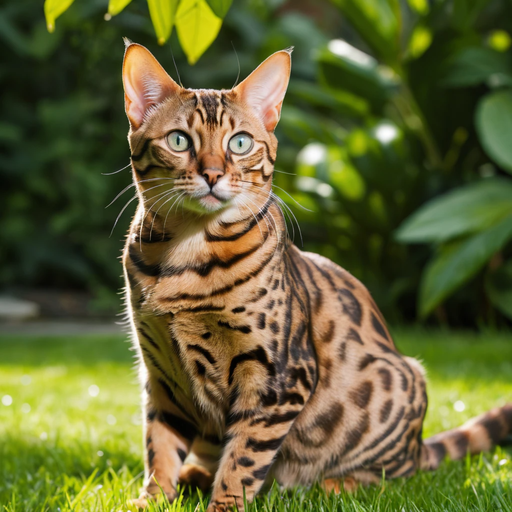
Housing, Enrichment, and Exercise for Exotic Cat Breeds
Exotic cat breeds thrive when their environment satisfies both physical and mental stimulation. A bland, empty apartment can quickly lead to stress, destructive behavior, and health problems.
Essential Enrichment Elements
- Vertical space – Tall cat trees, sturdy shelves, and window perches encourage climbing.
- Interactive toys – Puzzle feeders, feather wands, and motorized “mouse” toys mimic hunting.
- Scratching posts – Offer both vertical (sisal) and horizontal (cardboard) surfaces.
- Safe outdoor access – A secure catio or supervised harness walks let active breeds like Savannahs explore safely.
Sample Daily Exercise Routine
- Morning chase (15 min) – Use a wand toy to simulate prey pursuit.
- Midday puzzle (5 min) – Food‑dispensing ball keeps the mind occupied.
- Evening exploration (10‑20 min) – Rotate toys weekly and, if possible, supervise an outdoor stint.
Housing Considerations
- Quiet rest area – Provide a covered bed or soft blanket in a low‑traffic corner.
- Temperature control – Hairless cats need warm spots; heated pads work well.
- Litter box hygiene – One box per cat plus an extra; keep it clean to avoid urinary issues.
A well‑structured environment reduces anxiety, promotes healthy activity, and deepens the bond between you and your exotic cat breed.
Legal and Ethical Considerations for Exotic Cat Breeds
Because some exotic cat breeds have wild ancestry, regulations vary by country, state, and even municipality. Ignoring legal requirements can lead to fines, seizure of the animal, or ethical complications.
Key Points to Verify
- Local legislation – Certain hybrids (e.g., F5+ Savannahs) are prohibited in some states.
- Permit requirements – Some areas demand a wildlife permit or registration for exotic breeds.
- Breeder transparency – Ensure the breeder provides health clearances for hereditary conditions and complies with the Animal Welfare Act.
- Conservation impact – Purchasing from reputable breeders helps curb illegal wildcat trafficking.
- Insurance – Some pet insurers charge higher premiums for exotic breeds due to perceived risk.
Before bringing an exotic cat breed home, contact your local animal control office and verify any necessary paperwork. Ethical sourcing protects both the animal and the broader ecosystem.
Finding a Reputable Breeder or Rescue for Exotic Cat Breeds
A responsible acquisition begins with solid research. Whether you choose a breeder or a rescue, follow these steps to ensure the cat’s health and welfare.
- Verify credentials – Ask for registration with recognized cat associations (CFA, TICA) and proof of health testing.
- Visit the facility – Observe clean cages, socialized kittens, and attentive staff.
- Request health records – Look for vaccination history, FVRCP, FeLV, and any genetic test results.
- Check for guarantees – Reputable breeders often offer a health guarantee (usually one year).
- Consider rescue groups – Many exotic‑breed rescues specialize in re‑homing senior cats, which can be a rewarding, lower‑cost option.
Never purchase from a “back‑yard” seller or an online marketplace without meeting the animal in person. A responsible breeder will also ask you questions to ensure you can meet the breed’s specific needs.
FAQs
How much exercise does a Bengal need each day?
Bengals typically require at least 30 minutes of active play plus mental stimulation such as puzzle toys. Without sufficient exercise, they may become bored and engage in destructive behavior.
Are hairless cats like the Sphynx more prone to cold?
Yes. Because they lack insulating fur, Sphynx cats lose heat quickly. Provide warm blankets, heated beds, and keep the ambient temperature between 68‑75 °F (20‑24 °C).
Can I keep a Savannah cat outdoors?
Savannahs have a strong prey drive and may try to chase wildlife. If you allow outdoor time, use a secure catio or a harness‑trained walk to protect both your cat and local wildlife.
Do exotic cat breeds require special veterinary care?
Many exotic breeds benefit from breed‑specific screenings (e.g., cardiac echo for Savannah, retinal exams for Egyptian Mau). Regular wellness exams every six months are advisable for early detection of hereditary issues.
Is it legal to own a Serval‑cross Savannah in my state?
Regulations differ widely. Some states restrict hybrids beyond the F2 generation, while others allow up to F5. Check with your local animal control agency and obtain any required permits before purchase.
Conclusion
Understanding exotic cat breeds goes beyond admiring their striking looks; it means recognizing their unique nutritional, health, and environmental needs.
By matching the right breed to your lifestyle, providing balanced nutrition, regular grooming, mental enrichment, and adhering to legal guidelines, you set the stage for a vibrant, rewarding partnership.
Take the next step by researching reputable breeders or rescues, budgeting for specialized care, and preparing a stimulating home environment—your future feline companion will thank you with endless curiosity, affection, and a dash of wild‑type wonder.
